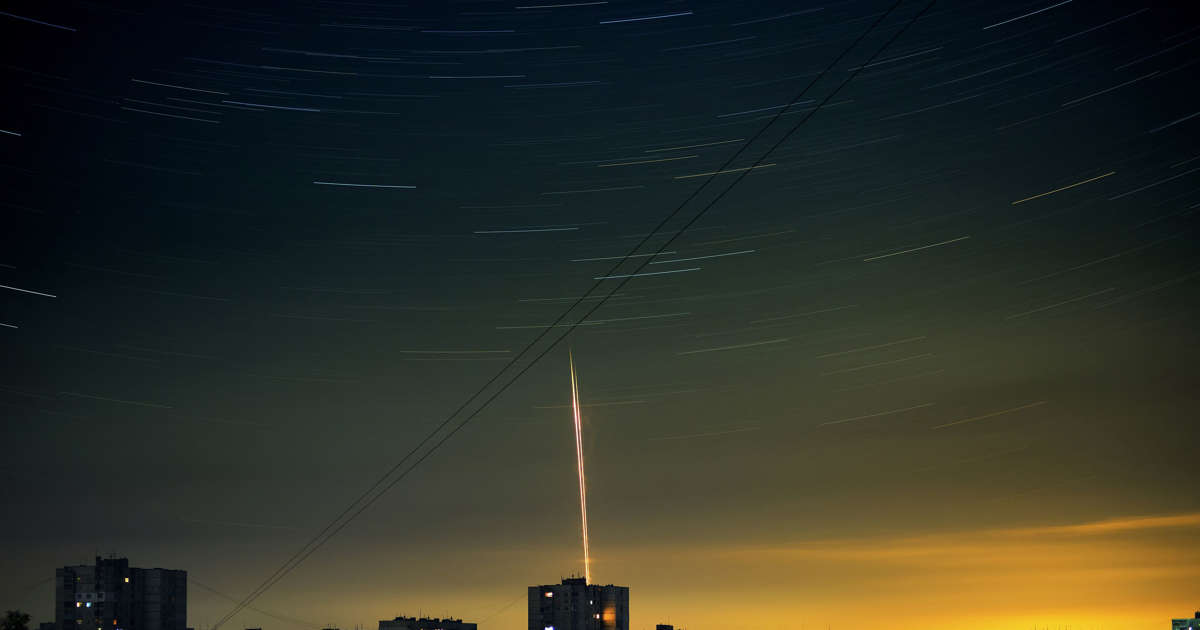[ad_1]
© Courtesy Museum of Fine Arts
Vadym Belikov, “Launch of S-300 missiles from the territory of Belgorod (Russia) towards Kharkiv (Ukraine). . . .” 2022
Strictly speaking, “Who Holds Up the Sky?” is a notably small show. It consists of just six photographs, along with a slide show, a video, and an extensive set of images from a visual graphic diary. The exhibition runs through May 21 at the Museum of Fine Arts. Yet there’s nothing small about its subject matter, the war in Ukraine.
The show’s limited size has the advantage of allowing it to be hung by the museum’s Sharf Visitor Center. That location makes it harder to overlook. Forty-five-hundred miles from the front lines and now more than a year into the fighting, it’s understandable if museumgoers find themselves forgetting about the war. As a nation, the United States has safety, security, and peace. “Who Holds Up the Sky?” reminds us how much Ukraine does not. All photographic images document. Those here do something rarer: They bear witness.
The show has been jointly organized by the MFA, the Wartime Art Archive at the Museum of Contemporary Art NGO, Kyiv, and the Odesa Fine Arts Museum.
The six photographs dominate the show. Part of that dominance is a function of size. The smallest are 28 inches by 36 inches. The largest are 48 inches by 36 inches. The scale makes the images all the more arresting. Two of them evince the terrible beauty that has come to be associated with war photography.
Vadym Belikov shows the launch of a Russian S-300 missile. The loveliness of the image — and it is lovely — is subverted (poisoned?) by the knowledge that Belikov is located where the missile is aimed, the now largely destroyed city of Kharkiv; and he took the photograph from his apartment. It isn’t just war Belikov is showing us. It’s his life.
The war is part of Kostiantyn Polishchuk’s life in a different, even more immediate way. He’s serving in Ukraine’s military. His “Night Watch” alludes to Rembrandt’s famous painting of another military group. The example on display shows a group of soldiers from behind, silhouetted against the sky. “Silhouetted” makes them sound insubstantial. The bagginess of their combat gear lends them an overwhelming solidity.
The other four photographs could be mistaken for something other than what they are, images of war damage. Efrem Lukatsky’s from-on-high view of a crater left in an agricultural field by a Russian missile might look at first glance like a crop circle. Once one realizes what’s being shown, the image becomes a potent reminder of what happens when what is, in effect, the world’s breadbasket becomes an invader’s plaything. The caption informs us of the date when Lukatsky took the photograph, July 4. That makes it a different kind of reminder, at least for Americans.
The torn, tortured-looking war destruction in the three black-and-white photographs from Yana Kononova’s “X-Scapes” series resemble abstract sculpture, a toxic cross between Darth Vader and the work of Louise Nevelson. They look inhuman, malevolent.
As against that inhumanity and malevolence there is the record of everyday life during wartime found in Inga Levi’s “Double exposure” series. Starting two days after the Russians invaded, Levi began to do two daily drawings, hence the title, showing both the military and civilian realities of life in Ukraine. The text is in Cyrillic, but the drawings are easy enough to parse. The panels are presented on four columns, which they encircle, like a kind of flattened frieze. Whether intentionally or not, the architectural presentation recalls Trajan’s Column, in Rome. That column honors a victorious imperial conquest, yes, but soon enough the conquering empire collapsed.
The slide show, which lasts 14 minutes, and the video, which lasts 4, are in a corner of the center, on the Huntington Avenue side. The show is a kind of diptych: On the left, we see a young Ukrainian; on the right a series of photographs taken by her or him. There are four photographers in all, ranging in age from 7 to 13. They received their cameras from the Behind Blue Eyes project, and the video is about Behind Blue Eyes. The value of the slides and video is as a reminder of a truth so basic as to go easily unnoticed: the effect of the war on average people away from the battlefield, people like you or me, our children or grandchildren.
WHO HOLDS UP THE SKY?
At Museum of Fine Arts, 465 Huntington Ave., through May 21. 617-267-9300, www.mfa.org
[ad_2]

